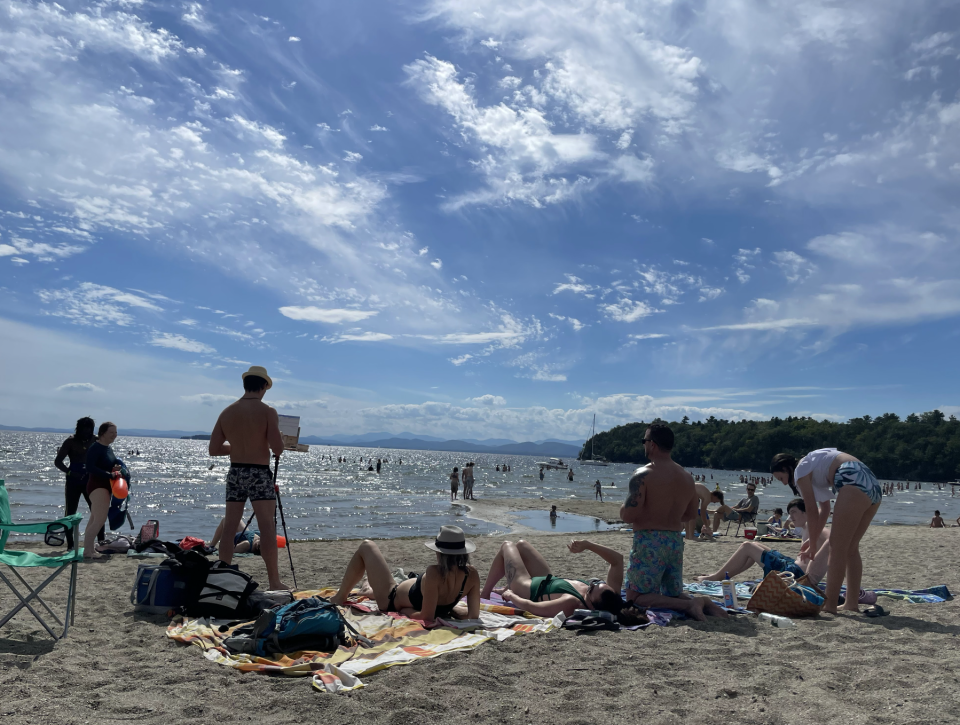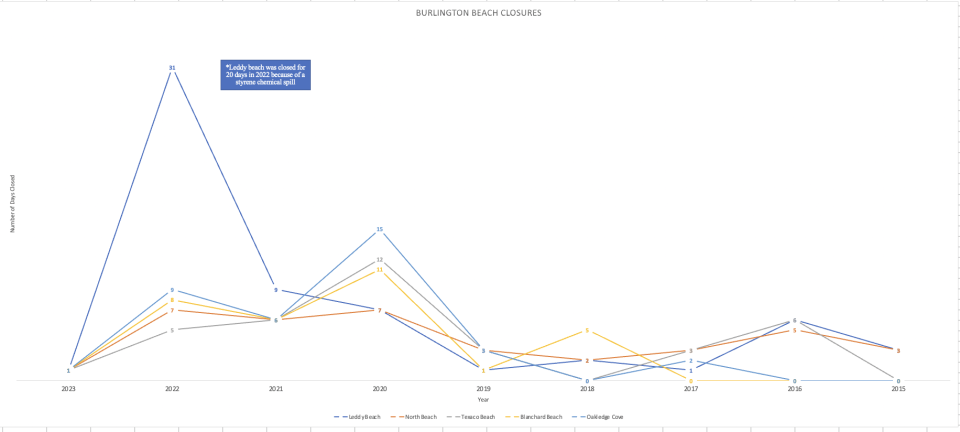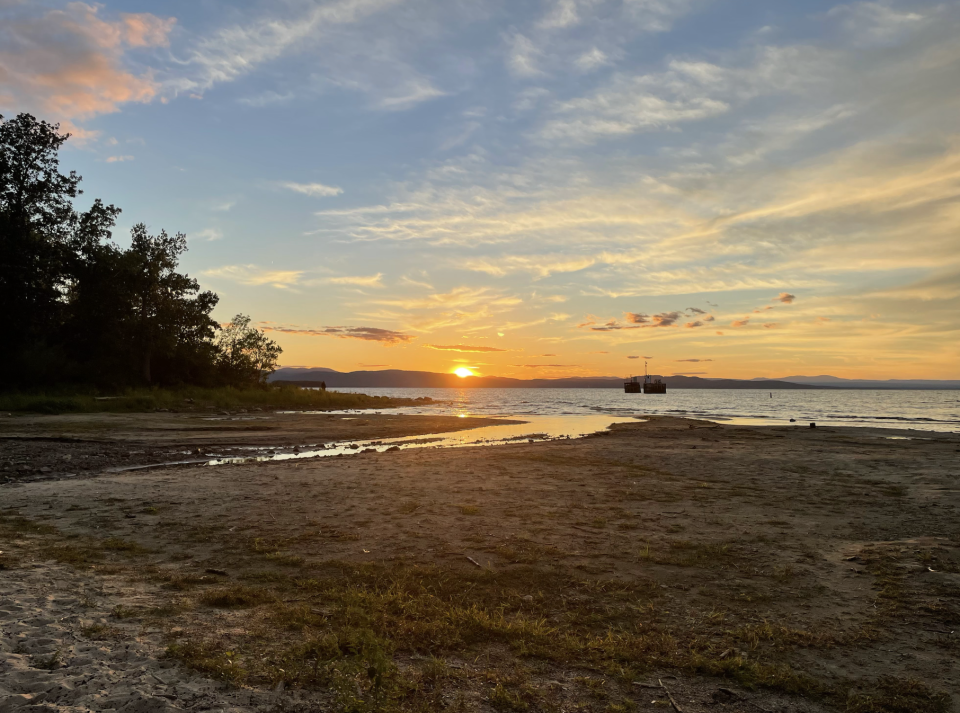Burlington beach closures are happening earlier in the season. Here's why.
The last weekend of June, Burlington swimmers have turned away from their beaches with this summer’s first cyanobacteria bloom, also known as blue-green algae. June 25 sighting came earlier than in previous summers. Normally blooms typically don't shut down beaches until July.

Cyanobacteria, naturally exist in freshwater bodies like Lake Champlain. Certain blooms of cyanobacteria can release toxins called cyanotoxins, posing risks to humans, animals, and the environment. Blooms happen with warm temperatures, still water, and high nutrient levels like phosphorus and nitrogen.
Cyanobacteria has been a concern for Lake Champlain since 1999 when two dogs swimming in a severe cyanobacteria bloom lost their lives after ingesting the bacteria.
Data on beach closures
A state assessment noted that Vermont has warmed 2 degrees in the last century. This summer the National Weather Service forecasts Vermont to see above-normal temperatures compared to previous decades. Just as the weather gets warmer and more people want to enjoy a swim in the lake, the chance for cyanobacteria to appear increases.
While no Burlington Beach closes notably more than the other beaches, Leddy Beach has the most closures, with Blanchard closing the least. Since 2015, Blanchard closed for 32 days, Oakledge Cove and Texaco Beach have both closed for 36 days, North Beach for 37 days, and Leddy Beach for a total of 61 days. A styrene chemical spill shut down Leddy for 20 days in 2022. 2022 saw a record high of 60 total closures, 10 times the number of beach closers in 2015.

Burlington Parks, Recreation & Waterfront is used to closing beaches in July and August, but in the past three years, they have begun to close beaches from June all the way through October.
"This one that just happened, that was one of the earliest ones that I can think of on our beaches. We've had some in June and even May, at points like the Coast Guard ramp and over by the sailing center or in the marina areas where the water's kind of stagnant," said Alec Kaeding, the waterfront parks and operations manager for Burlington Parks, Recreation, and Waterfront.
What makes cyanobacteria go away
Cyanobacteria is naturally present in most freshwater bodies like Lake Champlain and poses no harm. However, under specific conditions, such as calm and warm water with elevated phosphorus levels, blooms release toxins called cyanotoxins into the water which pose a risk to both humans and animals.
Circulating water and storms can disrupt cyanobacteria blooms, enabling Burlington beaches to reopen as early as the next day. However, prolonged periods of calm and hot weather with no wind exacerbate the growth and persistence of blooms.
Most Burlington beaches open within a day or two after the first sighting of a bloom. However, areas like Missisquoi Bay and St. Albans Bay face more extended closures, sometimes lasting an entire month. The accumulation of blooms in these locations makes it difficult for even strong winds to effectively break them up.
“In St. Albans for example, the beach is closed for the whole month of August, unfortunately, because the bloom is just built up to the point where even on a day with a heavy wind, it isn't really enough to break up the bloom," said Eric Howe, the executive director of the Lake Champlain Basin Program.
Back in Burlington, wind direction seems to determine which beaches may close.
"We have noticed that if there's a northern wind, we can bet that North Beach and Blanchard Beach are probably going to close," Kaeding said. "When we start looking at Leddy, Oakledge Cove, and Texaco Beach and at the way, everything's situated, the wind from the south doesn't hit those beaches because they're all protected.
Lake Champlain's big watershed contributes to the blooms
Lake Champlain's extensive watershed also contributes to cyanobacteria blooms.
"For every square mile of lake surface area, there are 18 square miles of land that drain into the lake, which is quite significant," Howe said. The larger watershed exposes the lake to higher levels of sediment and runoff from farms and urban areas, which contain the phosphorus and nitrogen on which cyanobacteria feed.
Blooms tend to happen along the shoreline, according to Howe, but can also happen in the middle of the lake.
“It's often later in the summer when the surface of the water is warmer and we’ve had several days in a row of hot, calm, sunny weather to warm up that a couple feet or so of the surface of the of the broad lake ,” Howe said.
Not all cyanobacteria blooms are toxic, but act like they are!
Not all cyanobacteria blooms are dangerous, and researchers are still trying to understand what other conditions make cyanobacteria release toxins.
"We don't fully understand yet what the rest of the recipe is to trigger the growth or production of toxins," Howe said.

Despite some cyanobacteria not being toxic the Burlington Parks, Recreation and Waterfront still shuts down beaches when they see a bloom.
"We don't know if it may be safe to swim, because we can't test it until it breaks up and you don't know if it's toxic until then," Kaeding said.
Swimming in toxic cyanobacteria can have serious consequences on a person's health, according to Bridget O'Brien, the Vermont Department of Health's senior radiological and toxicological analyst.
O'Brien said that kids and dogs are among the more vulnerable populations because of their tendency to accidentally drink water and because they're getting more of a dose per their smaller body size.If the bacteria come in contact with the skin, they can cause rashes and skin irritations. If people swallow water with high levels of the toxics, health effects include abdominal pain, diarrhea, vomiting or even liver damage.
"Other toxins have neurological effects that result in symptoms like numb limbs, limp fingers and dizziness," O'Brien said.
Even if the cyanobacteria isn't toxic, the Department of Health's motto is, “When in doubt, it is best to stay out.”
Contact Free Press staff writer Isabella Infante at iinfante@gannett.com
This article originally appeared on Burlington Free Press: How often does Burlington close beaches over water quality worries?

